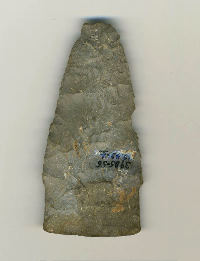
Scottsbluff point from Stratum 6.  |
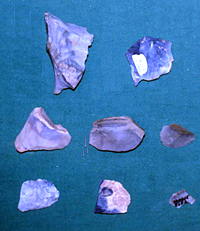
Examples of chipped-stone tools. Photo by Albert Redder.  |
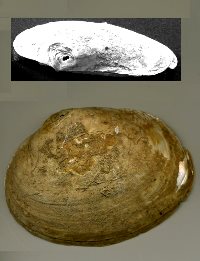
Mussel shell with battered hole in umbo portion, an intriguing yet puzzling pattern seen throughout the Paleoindian levels in the shelter. None of the mussels with battered umbos showed use or wear. Enlarge to see additional specimen.  |
|
Stratum 6: Red Gray Mix
Stratum 6 is a mixture of cave deposit and red river sand, the apparent result of human activities. This stratum marks the end of a dry period which allowed the thick deposit of decomposed rock "flour" from the ceiling to build up.
One Scottsbluff point was recovered from this stratum, as well as an unidentified, heavily resharpened, expanding stem point (possibly a reworked Wilson). Bifaces and utilized flakes also were found. Gravers with long delicate points were more common in Stratum 6 than Stratum 5. Two unifaces from Stratum 6 were different from those found in underlying deposits. These were made on blades, and both the sides and the distal end were utilized.
Animal bone and mussel shell were recovered. Several of the mussel shells had perforated umbo portions; on some, the holes extended through the full thickness of the shell. It is not clear whether this puzzling modification was a natural phenomenon or done by humans. Edges of the holes still appeared sharp, that is, not worn or rounded, as would have been the case had the shell been tied to a cord or hafted. Shells with similar battered holes were recovered from other layers, but none showed signs of use or wear. Also of unusual interest are two fragments of eggshell, about the curvature and thickness of a chicken egg.
Based on the two projectile points as well as the stratigraphic position of the deposit, Stratum 6 can be attributed to Late Paleoindian occupations. |
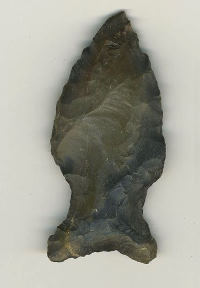
Unidentified expanding stem point that has been heavily reworked. Note similarities to type Wilson.  |
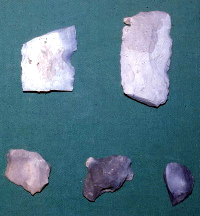
Chipped-stone bifaces, scrapers, and gravers from Stratum 6. Enlarge to see additional examples. Photo by Albert Redder.  |
|




